From the May 2021 issue of Apollo. Preview and subscribe here.
A few years ago, when Michael Rakowitz’s statue of a lamassu – a winged god from ancient Assyria, in what is now Iraq – sat on the Fourth Plinth in Trafalgar Square, I would often stop by to see it. I liked how its reflective surface, made out of brightly coloured tin cans, layered along the body like scales and folded into feathery shapes, would change according to the weather. Unlike the monochrome monuments that make up the rest of Trafalgar Square, the lamassu, Rakowitz’s reconstruction of a statue originally from the palace of Nineveh that was destroyed by ISIS after the fundamentalist group took over much of Iraq in 2014, never quite seemed to sit still.
On a bright summer’s day in 2018, I was passing by when an Iraqi couple, obviously new to London and doing some sightseeing, asked me to take their picture in front of the lamassu. ‘This is from our country,’ one said, both of them looking delighted – and surprised – to find this interloper amid the imperial pomp of central London as they posed for the photo. The encounter was unplanned, of course, but it was the kind of thing that Rakowitz, who talks of his art as an ‘open system’, hopes for in his works, many of which make creative use of public space. ‘Those moments where people participate allow for the work to go on, beyond my own hands and beyond my own mind,’ he tells me when we speak over the phone in March this year.
The Iraqi-American artist’s newest work, a life-size cast of a British soldier who took part in the occupation of Basra after the US-led invasion of Iraq in 2003, takes a similar approach to public space. After a year of delays due to the pandemic, April is the cruellest month is (at time of writing) to go on public view on 1 May. It will stand on the sea-front at Margate, facing off against the Surf Boat Memorial, a late 19th-century statue commemorating nine rescuers who lost their lives answering a distress call off the coast of this town in Kent. This new work continues Rakowitz’s long-running interest in reconstruction, using objects to explore issues such as war, trauma and cultural loss – but while he describes previous works such as the lamassu as ‘reappearances’, he wants this statue to feel more like ‘a kind of a haunting’.
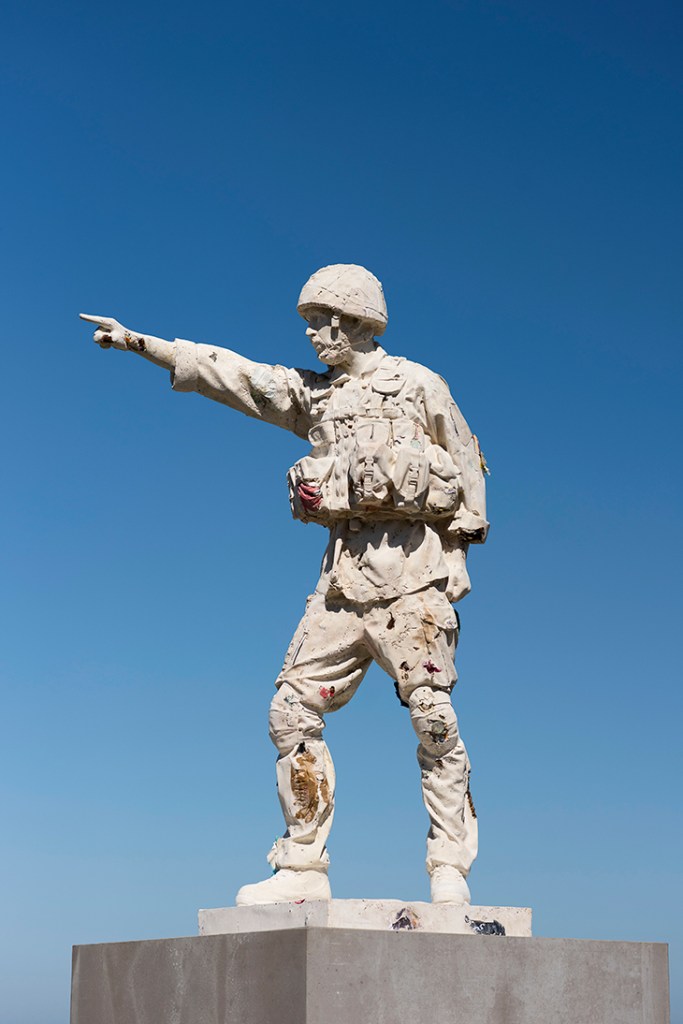
April is the cruellest month (2021), Michael Rakowitz. Photo: Thierry Bal; courtesy England’s Creative Coast
April is the cruellest month uses the figure of Daniel Taylor, a former British soldier who served in Basra for several months in 2007, when troops had lost control of the city and were trapped in their base under almost constant rocket fire. Taylor, who was later diagnosed with PTSD, is now a member of Veterans for Peace UK, the British branch of a movement that began in the United States, which campaigns against the use of war as a foreign policy tool. While the figure in the lifeboat statue looks out to sea, Taylor looks inland, pointing accusingly in the direction of Westminster. On the plinth beneath his feet is an inscription from the First World War poet Siegfried Sassoon: ‘I believe that this war, upon which I entered as a war of defence and liberation, has now become a war of aggression and conquest.’
The statue, which I saw in storage shortly before its installation, is cast in white concrete, into which a collection of materials is embedded. These include mementos of war donated by Taylor and other Veterans for Peace members, and sand from Basra and chalk from the Kent coast collected by Rakowitz – as well as what the artist calls ‘votive objects’ made by local Kent residents, via workshops organised by Turner Contemporary, who commissioned the statue as part of the wider ‘Waterfronts’ series of outdoor installations along the south-east coast of England. Among the objects embedded in the statue is Taylor’s service medal; an echo of Sassoon, who was said to have thrown his Military Cross into the river Mersey in 1917. (In 2007, Sassoon’s medal in fact turned up in a relative’s attic.)
By physically forcing these materials together, Rakowitz explains, ‘I wanted to mimic the compression that happens through geology. I think about the traumas that happen in human history, and then I think about the traumas that are registered through geology.’ The statue, he said, bears evidence of Britain’s historic, violent relationship with Iraq, just as a vein in a rock points to the moment that the rock cracked and water rushed in to fill the gap. Taylor’s pose is taken from a Saddam Hussein-era monument that once stood in Basra and featured the figures of young men who had fought in the Iran-Iraq war, pointing towards the Iranian border. After the 2003 invasion, it was torn down and thrown into the Shatt al-Arab river: April is the cruellest month presents a ghostly, barnacled apparition, who has emerged from the water.
Yet if this all seems neatly designed, the idea came to Rakowitz through a series of chance encounters, when he visited the English coast for the first time in 2019, at the invitation of Turner Contemporary. Already fascinated by the way the English Channel separates Britain both literally and symbolically from the continent, arriving in Margate and seeing the Surf Boat Memorial – a statue of a man in waterproofs looking out to sea – only deepened his interest in ‘the coast as a kind of space where hospitality and hostility intersect’. A little way along the beach, he discovered, was the shelter in which T.S. Eliot wrote part of The Waste Land (1922), from the opening line of which the statue’s title is taken.
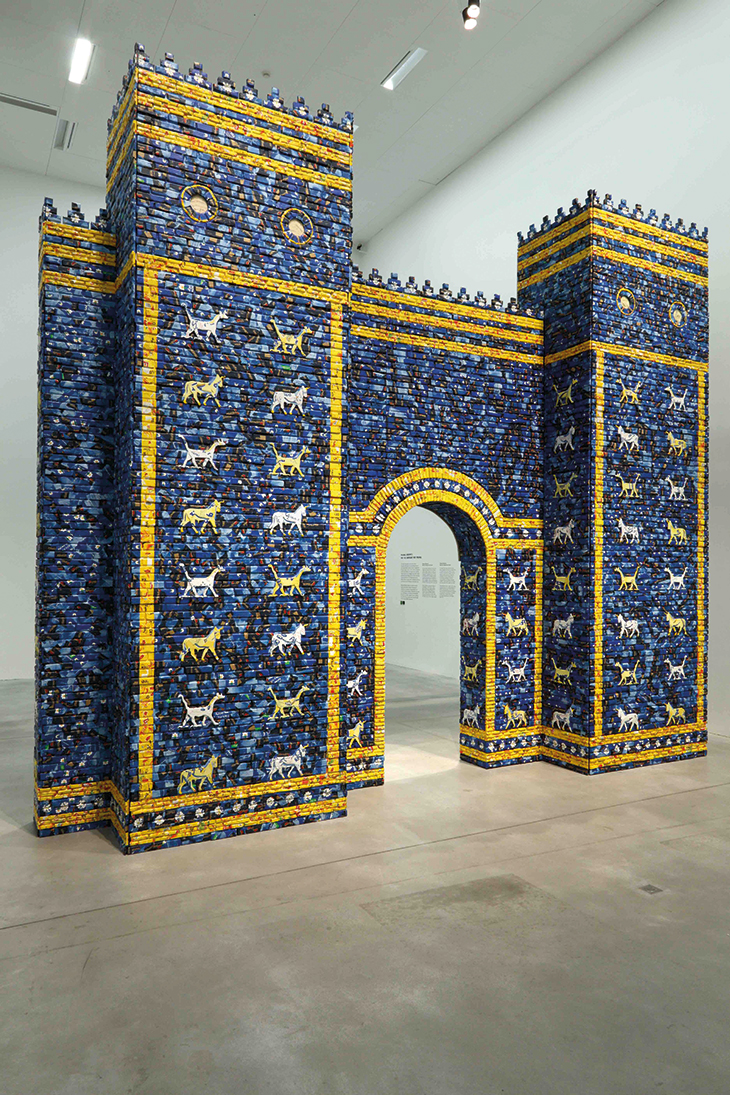
May the arrogant not prevail (2010), Michael Rakowitz. Museum of Contemporary Art, Chicago. Photo: courtesy the artist and Rhona Hoffman Gallery; © MCA Chicago
That, for Rakowitz, set off a personal reflection: ‘I have this childhood memory of my Iraqi grandfather passing away suddenly in April 1975, but April 2003 was when the city of Baghdad and the city of Basra were overtaken by the US and British forces. So April has always kind of represented this moment where instead of it being a month about rebirth it has always been about loss for me.’ Thinking about these connections, he says, led to a process of collecting objects, at first ‘without knowing exactly what I [was] doing with them’.
This way of working has run through Rakowitz’s career as an artist. Born in Great Neck, New York, in 1973, to parents of European and Iraqi Jewish backgrounds, he studied graphic arts in the early 1990s, developing particular interests in sculpture and public art, the latter via a stint at the Massachusetts Institute of Technology’s architecture department. Today, he is a professor of art theory and practice at Northwestern University near Chicago, where he lives with his family – and where he is when we speak.
Many of Rakowitz’s works draw on his family background – his maternal grandparents were part of the deeply-rooted community of Baghdadi Jews largely driven out of the country in the mid 20th century – and his collecting habits owe more than a little to his childhood passion for baseball cards. But these personal motivations intertwine with an outward-looking interest in communities who have been dispossessed or uprooted, and the potential of public art both to expose trauma and help people find ways of resolving it.

What dust will rise? (2012), Michael Rakowitz (installation view at Documenta 13). Photo: Roman März; courtesy the artist
Rakowitz has designed inflatable shelters for homeless people in the United States based on Bedouin tents in the Middle East (paraSITE; 1998) and built a replica of the Soviet revolutionary Vladimir Tatlin’s Monument to the Third International with the help of Aboriginal communities in Sydney, Australia (White man got no dreaming; 2008). In 2012 he commissioned stonemasons to recreate books destroyed in the Allied bombing of Germany during the Second World War out of the same Afghan sandstone that was used to build the Bamiyan buddhas, dynamited by the Taliban in 2001 (What dust will rise?). Chance encounters, surprising connections and the involvement of collaborators and audiences all go into shaping the art. ‘I want the situation to sculpt the work as well as my hands,’ Rakowitz tells me. One such moment of serendipity arrived during the research for April is the cruellest month, when the artist discovered he was distantly related to Sassoon, who also came from a Baghdadi Jewish family.
Although the themes are complex – one mixed-media project, The Breakup (2010–ongoing), juxtaposes the splitting-up of the Beatles in the late 1960s with the concurrent collapse of pan-Arabism in the wake of the Six-Day War – the resulting artworks often have a more immediate emotional appeal. The lamassu that provoked the shock of recognition in the couple I met by the Fourth Plinth is part of The invisible enemy should not exist (2007–ongoing), a series in which Rakowitz reconstructs and embellishes artefacts looted or destroyed since the invasion of 2003, many of them clad in similar coloured tin cans. Works from this series were recently displayed at the Nasher Sculpture Center, Texas (together with a video, The Ballad of Special Ops Cody), and are currently on show at the Wellin Museum of Art, New York State.
The patterned surfaces of his works may be intricate and pretty, but the material is an essential part of the artefacts, taken from cans of Iraqi date syrup – one of Iraq’s major exports, and a product sold in the United States by Rakowitz’s maternal grandfather, who established an import-export business after he was displaced from Baghdad. For Rakowitz, the syrup cans, which for many years had to be badged as the produce of other Middle Eastern countries, because of US sanctions, became a material that could be invested with layer upon layer of meaning. ‘[The syrup] really did become this binder, a sticky substance that started to pull in a lot of different things,’ he tells me.
I find the way Rakowitz talks about objects particularly interesting because, as a journalist who spends a lot of time asking people to tell me their stories – or writing about the stories revealed by works of art – it feels as if his approach goes in the opposite direction. He gathers objects together in a way that allows meaning to accrete, like layers of silt over time, until something new is born. ‘I wanted to create a new kind of rock,’ he says of the material that comprises April is the cruellest month.
Rakowitz puts this approach partly down to his own family history of displacement, from Iraq on one side and from post-Holocaust Europe on the other. ‘When my grandparents left Iraq, whatever they could carry out with them was holy, because it was a connection to a place they could no longer belong to,’ he says. ‘An object holds value in a museum or in our lives because of where it says it’s from.’
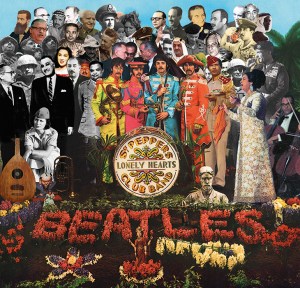
The Breakup (2012), Michael Rakowitz. Courtesy and © the artist
Public art, however, isn’t only about the stories internal to the objects. Rakowitz intends his projects to be interventions that encourage what he describes as ‘fearless speaking, fearless listening’. A musical performance that formed part of The Breakup, for instance, featured members of the Palestinian rock band Sabreen playing Arabic-inflected Beatles covers on a Jerusalem rooftop, ordered ‘to form a kind of poem about collaboration and collapse’. The plan for April is the cruellest month, Covid permitting, is to hold a series of events at the site throughout 2021, including a reprise of Rakowitz’s Enemy Kitchen – a cooking workshop in which Rakowitz introduces participants to Iraqi recipes passed down from his mother – and a procession by members of Veterans for Peace UK to coincide with Remembrance Day.
April is the cruellest month has a clear anti-war message. I speak to Taylor, its subject, by phone shortly before the statue is unveiled. He tells me that he thinks there is a good chance the statue will upset military veterans who don’t share his politics. ‘I want to open up conversations around how we can try and do things better,’ he tells me. ‘If we can reach out to just one veteran who feels they can’t ask for help, because they have to be this hero, that’s not such a bad thing. And if it gets people thinking about the way we spend our money on the military, then that would be my dream.’
The placing of the statue beside a stretch of water that refugees from Iraq and elsewhere are attempting to cross on a daily basis is no accident, either. ‘You can’t go and do those things in the world and expect that there isn’t going to be a seismic shift that’s going to register on your own scales,’ says Rakowitz. The interplay between Taylor, pointing towards Westminster, and the older, 19th-century statue looking out across the Channel expresses ‘a certain cluelessness’ on the part of the people who make decisions to go to war.
Like Taylor, Rakowitz sees the statue – unveiled at a moment the British right has encouraged a moral panic about a perceived threat to war memorials from Black Lives Matter protestors – as an opportunity for dialogue as well as confrontation. ‘I don’t see it as a crisis between the right and the left to introduce anti-war memorials into the lexicon of memorials that we have in the world. It doesn’t threaten the memory of anyone,’ he says. ‘The moniker of so many of these [wars] is “the war to end all wars” and we know that will never happen, that there’s just going to continue to be more – but there might not be more if we liberate ourselves from simple sloganeering and we actually allow for these spaces to become not just about remembrance and celebration, but to actually talk about grief.’
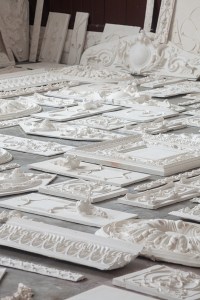
The flesh is yours, the bones are ours (2015), Michael Rakowitz. Photo by Sahir Ugur Eren; courtesy the artist and Istanbul Foundation for the Arts
Rakowitz’s artworks often aim to make trauma visible where it has been hidden. A project for the 2015 Istanbul biennial, The flesh is yours, the bones are ours, involved making paper rubbings and plaster casts of art nouveau decorations, many of which were made by Armenian craftsmen only a few years before the Armenian genocide, that still adorn the city’s early 20th-century buildings. With April is the cruellest month, trauma becomes part of the statue’s physical appearance. Deep fissures run like scars down the concrete surface, where the seams from the silicon mould used to cast the sculpture have been allowed to show. The donated objects, which were placed into the mould before concrete was poured in, poke through the surface: a piece of ribbon, the stone from a date, a shard of metal. To me, they look like wounds: the site of injury, but also – potentially – of healing.
‘I think about healing a lot,’ Rakowitz says. ‘My dad is a doctor and I think that he really impressed his own ethos on me. I don’t set out to heal necessarily, as much as I set out to truly reckon with things. To distil material […] so that we can take it in is something that I think art can really allow people to do.’ It’s a way of working, he says, that is ‘simultaneously like problem-solving and trouble-making’.
It’s characteristic of Rakowitz’s work that this aim functions both on an abstract level and a very personal one. To make the statue, Taylor had to put on full combat gear and stand in a 3D-scanner at Shepperton film studios, so that the London-based art fabricators – the White Wall Company – could create a mould of his body. As Taylor tells me, this was the first time he had put on a uniform since he left the army a decade ago, at the age of 22. ‘I put the helmet on, I put body armour on, I dressed back up in that uniform,’ he says. ‘And for some reason, to take it off again did more for my mental health than years of intensive weekly therapy.’ It was only at that point that he decided to hand over his medal. ‘I realised this is what I need to do now. I can’t explain it, I just felt safe.’
April is the Cruellest Month is a ‘Waterfronts’ commission with Turner Contemporary for England’s Creative Coast, on view in Margate from 1 May until 12 November 2021 (www.englandscreativecoast.com).
From the May 2021 issue of Apollo. Preview and subscribe here.
Unlimited access from just $16 every 3 months
Subscribe to get unlimited and exclusive access to the top art stories, interviews and exhibition reviews.


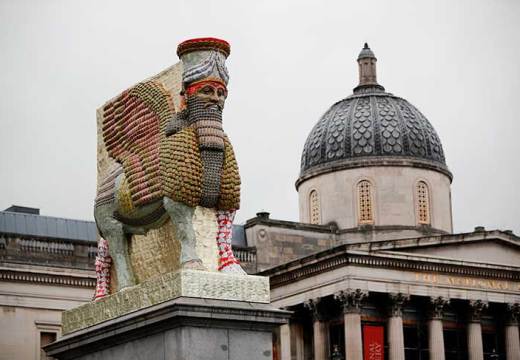
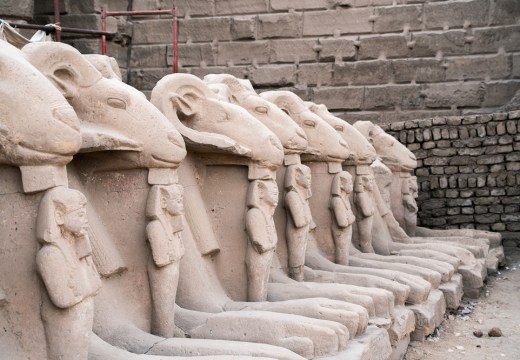
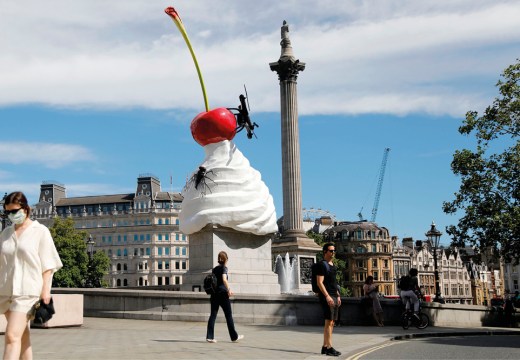









![Masterpiece [Re]discovery 2022. Photo: Ben Fisher Photography, courtesy of Masterpiece London](http://www.apollo-magazine.com/wp-content/uploads/2022/07/MPL2022_4263.jpg)
It’s time for the government of London to return to its rightful home